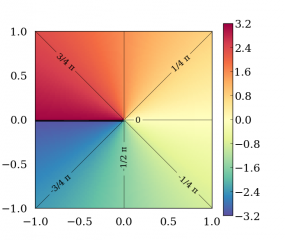std::atan2
From cppreference.com
| Defined in header
<cmath>
|
||
| float atan2( float y, float x );
|
(1) | |
| double atan2( double y, double x );
|
(2) | |
| long double atan2( long double y, long double x );
|
(3) | |
| Promoted atan2( Arithmetic1 y, Arithmetic2 x );
|
(4) | (since C++11) |
Computes the arc tangent of y/x using the signs of arguments to determine the correct quadrant.
4) A set of overloads or a function template for all combinations of arguments of arithmetic type not covered by 1-3). If any argument has integral type, it is cast to double. If any argument is long double, then the return type
Promoted is also long double, otherwise the return type is always double.
Contents |
[edit] Parameters
| x, y | - | values of floating-point or integral types |
[edit] Return value
If no errors occur, the arc tangent ofy/x (arctan(| y |
| x |
If a domain error occurs, an implementation-defined value is returned (NaN where supported)
If a range error occurs due to underflow, the correct result (after rounding) is returned.
[edit] Error handling
Errors are reported as specified in math_errhandling
Domain error may occur if x and y are both zero.
If the implementation supports IEEE floating-point arithmetic (IEC 60559),
- If
xandyare both zero, domain error does not occur - If
xandyare both zero, range error does not occur either - If
yis zero, pole error does not occur - If
yis±0andxis negative or-0,±πis returned - If
yis±0andxis positive or+0,±0is returned - If
yis±∞andxis finite,±π/2is returned - If
yis±∞andxis-∞,±3π/4is returned - If
yis±∞andxis+∞,±π/4is returned - If
xis±0andyis negative,-π/2is returned - If
xis±0andyis positive,+π/2is returned - If
xis-∞andyis finite and positive,+πis returned - If
xis-∞andyis finite and negative,-πis returned - If
xis+∞andyis finite and positive,+0is returned - If
xis+∞andyis finite and negative,-0is returned - If either
xis NaN oryis NaN, NaN is returned
[edit] Notes
std::atan2(y, x) is equivalent to std::arg(std::complex<double>(x,y))
POSIX specifies that in case of underflow, y/x is the value returned, and if that is not supported, and implementation-defined value no greater than DBL_MIN, FLT_MIN, and LDBL_MIN is returned.
[edit] Example
Run this code
#include <iostream> #include <cmath> int main() { // normal usage: the signs of the two arguments determine the quadrant std::cout << "(+1,+1) cartesian is (" << hypot(1,1) << ',' << atan2(1,1) << ") polar\n" // atan2(1,1) = +pi/4, Quad I << "(+1,-1) cartesian is (" << hypot(1,-1) << ',' << atan2(1,-1) << ") polar\n" // atan2(1, -1) = +3pi/4, Quad II << "(-1,-1) cartesian is (" << hypot(-1,-1) << ',' << atan2(-1,-1) << ") polar\n" // atan2(-1,-1) = -3pi/4, Quad III << "(-1,1) cartesian is (" << hypot(-1,1) << ',' << atan2(-1,1) << ") polar\n"; // atan2(-1,-1) = -pi/4, Quad IV // special values std::cout << "atan2(0, 0) = " << atan2(0,0) << " atan2(0,-0) = " << atan2(0,-0.0) << '\n' << "atan2(7, 0) = " << atan2(7,0) << " atan2(7,-0) = " << atan2(7,-0.0) << '\n'; }
Output:
(+1,+1) cartesian is (1.41421,0.785398) polar (+1,-1) cartesian is (1.41421,2.35619) polar (-1,-1) cartesian is (1.41421,-2.35619) polar (-1,1) cartesian is (1.41421,-0.785398) polar atan2(0, 0) = 0 atan2(0,-0) = 3.14159 atan2(7, 0) = 1.5708 atan2(7,-0) = 1.5708
[edit] See also
| computes arc sine (arcsin(x)) (function) |
|
| computes arc cosine (arccos(x)) (function) |
|
| computes arc tangent (arctan(x)) (function) |
|
| returns the phase angle (function template) |
|
| applies the function std::atan2 to a valarray and a value (function template) |
|
|
C documentation for atan2
|
|
